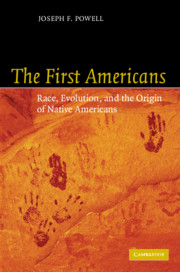Book contents
- Frontmatter
- Contents
- Acknowledgments
- Prologue: The Kennewick controversy
- PART I Race and variation
- PART II The Pleistocene peopling of the Americas
- PART III The First Americans, race and evolution
- 9 Racial models of Native American origins
- 10 Evolutionary models of Native American origins
- 11 The First Americans: Native American origins
- References
- Index
10 - Evolutionary models of Native American origins
Published online by Cambridge University Press: 21 August 2009
- Frontmatter
- Contents
- Acknowledgments
- Prologue: The Kennewick controversy
- PART I Race and variation
- PART II The Pleistocene peopling of the Americas
- PART III The First Americans, race and evolution
- 9 Racial models of Native American origins
- 10 Evolutionary models of Native American origins
- 11 The First Americans: Native American origins
- References
- Index
Summary
One of the greatest faults and impediments of anthropology has always been and is largely to this day, in spite of ever-growing evidence to the contrary, the notion of the permanence of skull types, and their changeability only through racial mixtures and replacements. It is time that this attitude be replaced by more modern and rational views on the subject, based on the steadily increasing knowledge of biological laws and processes, together with such powerful factors as segregation and isolation.
Hrdlička, 1935EVOLUTION AND THE PEOPLING OF THE AMERICAS REDUX
Microevolutionary models
Boas (1912a, b), attempted to reconcile the migrationist approach of the racial–typologists with models of in situ biological change resulting from natural selection or genetic drift. He thought that Native Americans originated through one, or more migrations that introduced some variation to the New World (Boas, 1912a). However, once these populations settled in the Americas,
… the isolation and small number of individuals in each community gave rise to long-continued inbreeding, and with it, to a sharp individualization of local types. This was emphasized by subtle influences of natural and social environment. With the slow increase in numbers, these types came into contact; and through mixture and migration a new distribution of typical forms developed.
Franz Boas (1912a, b)This viewpoint was at odds with the traditional interpretations of biological variation within and among Native Americans.
- Type
- Chapter
- Information
- The First AmericansRace, Evolution and the Origin of Native Americans, pp. 214 - 228Publisher: Cambridge University PressPrint publication year: 2005



